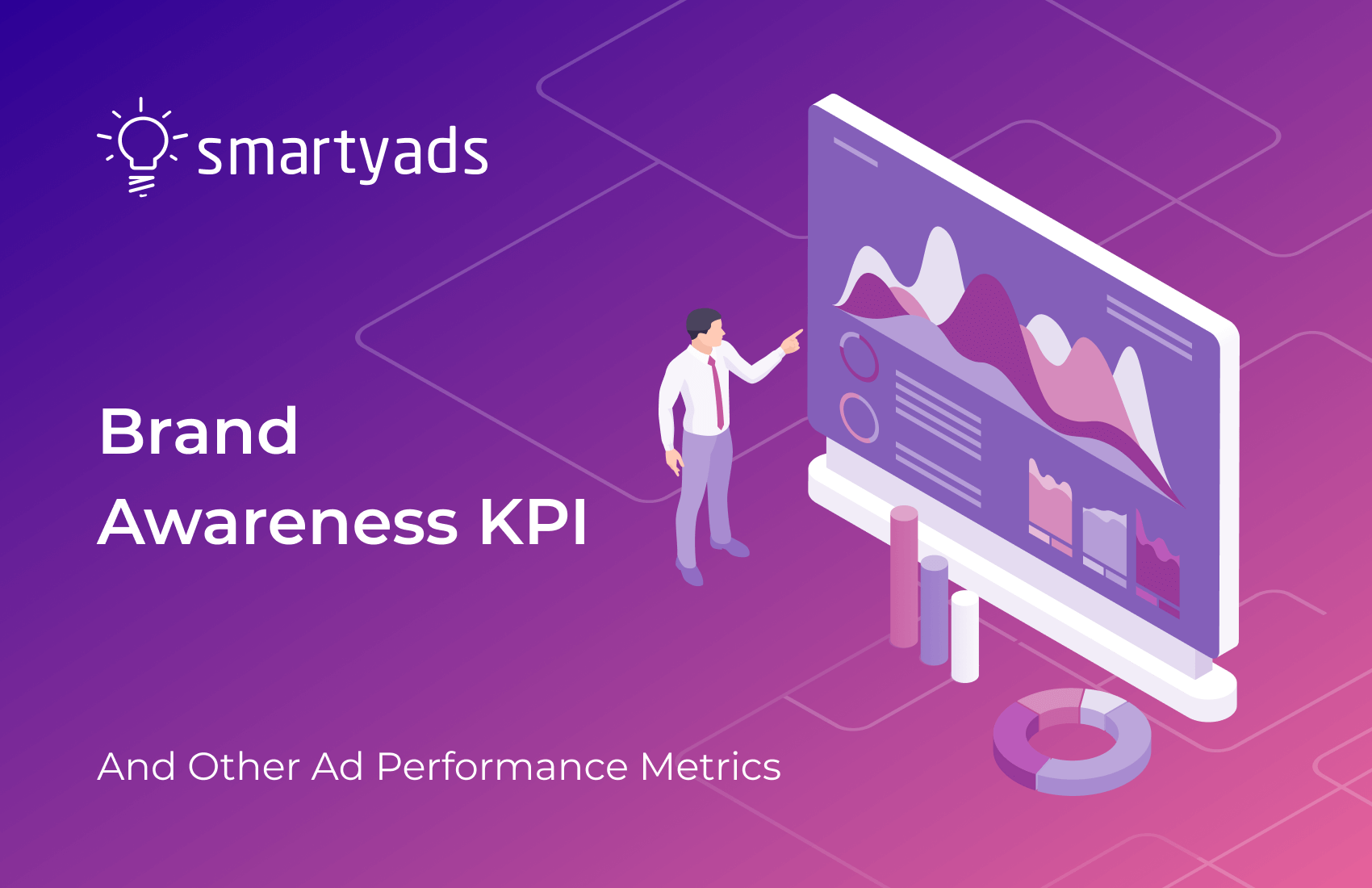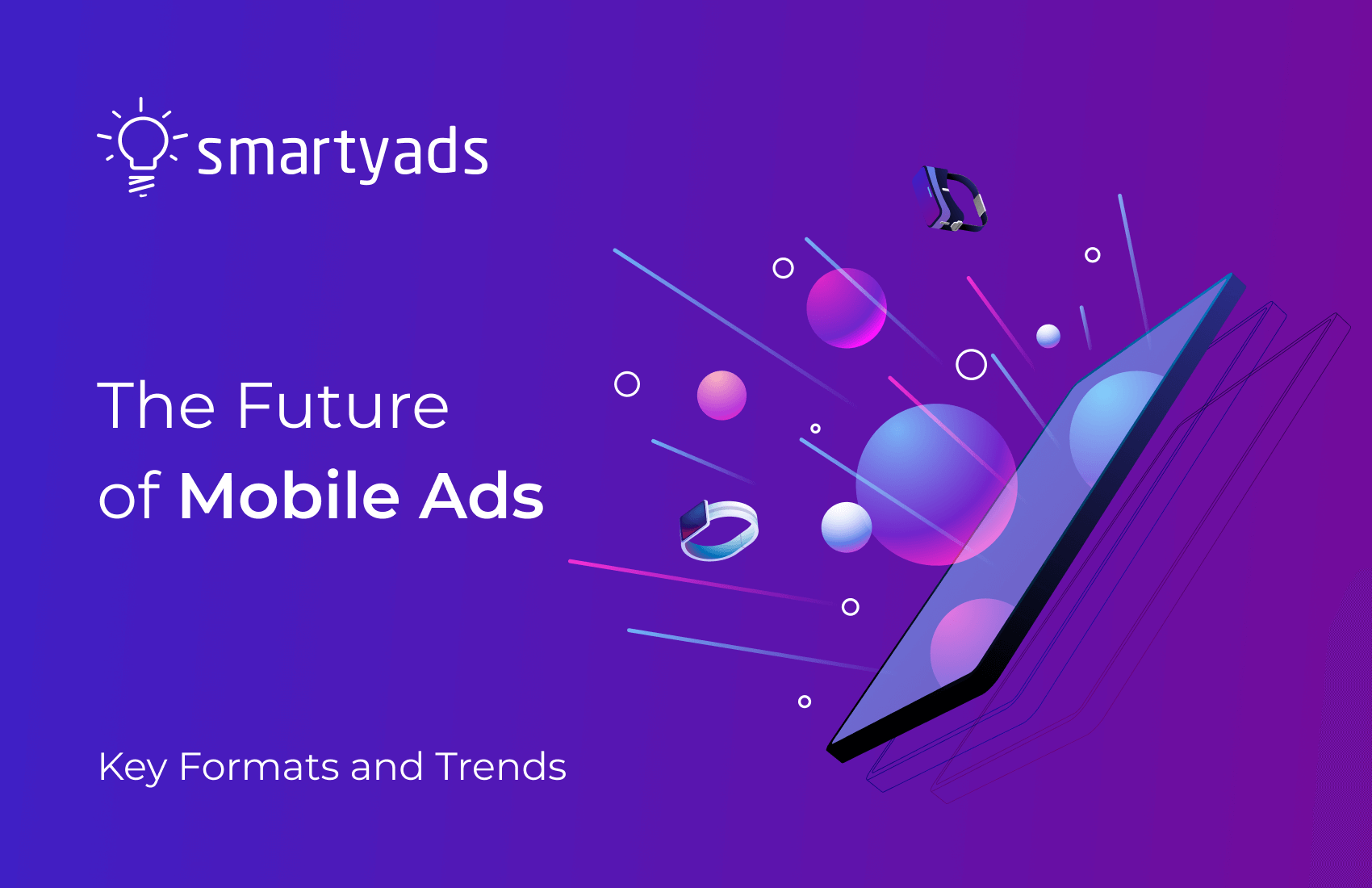Brand awareness KPIs are very important for every brand that wants to be recognized. However, less than half of those who measure branding metrics know how to do it. The importance of this metric is hard to underestimate, especially in B2B segments, where customer trust is paramount and clients need to be sure who they are buying from. Most consumers will buy from one of the top three brands that appear in their consideration set at the moment of purchase.
So, how exactly do you define brand awareness, how do you measure it, and what other metrics should you consider afterward?
Key Takeaways:
- Brand awareness is a top priority for marketers, but less than half effectively measure it — making KPI tracking essential for long-term growth.
- Top KPIs include product recognition, recall, identity, NPS, share of voice, branded search volume, impressions, CTR, and social engagement.
- Programmatic platforms like SmartyAds DSP allow real-time tracking of awareness metrics across channels (CTV, mobile, display), simplifying campaign analysis.
- Attention metrics such as viewability and video completion rate (VCR) reveal not just visibility but meaningful engagement.
- Measuring brand awareness at all funnel stages — from impressions to sales — enables smarter strategy, better optimization, and higher return on ad spend.

What is brand awareness?
Brand awareness is a level of familiarity and recognition your target audience has with your brand. It represents the extent to which consumers are aware of your brand's existence, name, logo, products, and overall identity. Measuring awareness involves assessing factors such as your recall, recognition, and associations. It is crucial to building brand equity and fundamental in shaping consumer perceptions, purchase decisions, and overall loyalty.
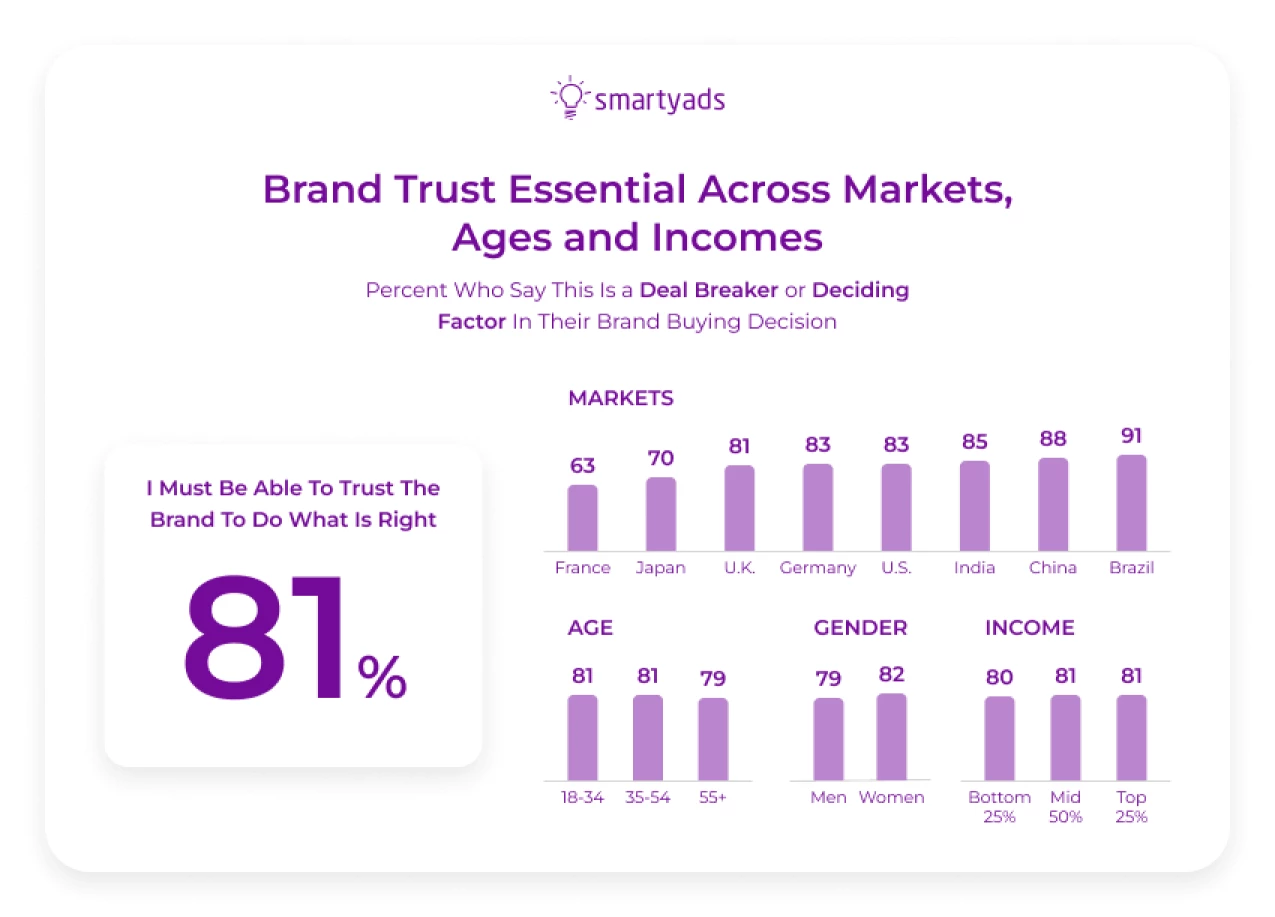
Top 10 KPIs to measure brand awareness
Before plunging deeper into each metric, let’s compare them in one table.
| KPI | What It Measures | How to Measure It | Best Use Case |
| Product Recognition | Brand familiarity based on visual cues (e.g., logo, name) | Logo/name recognition surveys | Awareness tracking pre/post campaign |
| Product Recall | Spontaneous brand mentions without cues | Unaided recall in surveys | Awareness tracking pre/post campaign |
| Product Identity | Consumer perception shaped by past experience and associations | Aided & unaided awareness questions | Deep understanding of brand impact and associations |
| Net Promoter Score | Willingness to recommend brand (indirectly tied to brand perception and awareness) | “How likely are you to recommend us?” on a scale of 0–10 | Measuring advocacy and deeper brand affinity |
| Share of Voice (SOV) | Brand visibility compared to competitors in the same category | Competitive media monitoring, PR mentions, ad spend share | Benchmarking against competitors |
| Traffic Search | Interest in brand reflected through branded keyword searches | Google Trends, keyword tracking tools | Monitoring online interest and brand growth |
| Social Media Engagement | Brand popularity and interaction level on social platforms | Likes, shares, comments, follower growth, sentiment analysis | Digital brand impact and engagement tracking |
| Impressions | Number of times your ad is shown | DSP analytics report | Reach measurement in programmatic campaigns |
| Click-Through Rate | Ratio of users who clicked on your ad after seeing it | Clicks ÷ Impressions (available in DSP dashboard) | Evaluating campaign engagement and message effectiveness |
| Viewability Rate | Percentage of ads that are actually viewable by users | MRC-standard tracking tools (e.g., 50% pixels in view for ≥1s) | Ensuring ads are seen, not just served |
| Video Completion Rate (VCR) | How many users watch video ads till the end | DSP video analytics | Gauging effectiveness of video content |
| Reach & Frequency | Reach = total unique users exposed; Frequency = avg. number of times a user saw the ad | DSP metrics dashboard | Balancing message saturation and audience size |
Measuring the success of brand awareness campaigns is a multifaceted and dynamic process that requires careful consideration of various factors. The effectiveness of brand awareness KPIs measurement largely depends on the specific marketing channel used for your campaign, as well as the methods you currently employ to measure your marketing goals. Let’s review some of the brand awareness KPI examples.
Product recognition
How familiar are consumers with your product? This typically involves showing a logo or company name and asking if they recognize it.
Product recall
How easily does your product come to mind when thinking about its category or type? How spontaneously does the brand come to mind when thinking about a product category?
Product identity
How do consumers perceive your product based on their experiences? It's also beneficial to ask a combination of aided and unaided brand awareness questions to gain a deeper understanding of the impact your product has.
Unaided question example: What product comes to mind when you think of smartphones?
Aided question example: Which of the following smartphone brands are you aware of (check all that apply)? Apple, Samsung, Google, OnePlus.
Net Promoter Score (NPS)
While primarily a loyalty metric, NPS can also reflect brand awareness indirectly by indicating how many customers are likely to recommend the brand to others.
Share of Voice (SOV)
Measures a brand’s presence compared to competitors within the same market. It calculates the brand’s share of conversations or mentions in a given category.
Traffic search
Tools like Google Trends and keyword research tools can be utilized to assess the branded search volume for your brand name and related keywords. Higher branded search volume indicates brand awareness growth and interest. Analyzing keyword performance and search trends can provide valuable insights into your brand's visibility in search engine results and identify emerging trends or topics that align with your brand.
Social media engagement
Monitoring social media platforms is essential for understanding the impact of your brand in the digital realm. A significant majority of consumers, amounting to 77%, express a preference for engaging in shopping activities with brands that they actively follow on social media.
So, how to measure brand awareness for social media engagement? By analyzing metrics such as mentions, shares, likes, comments, follower growth, and engagement rates, you can gauge the reach and effectiveness of your brand awareness efforts in the social media sphere. Additionally, sentiment analysis can help assess the overall sentiment surrounding your brand and identify potential areas for improvement.
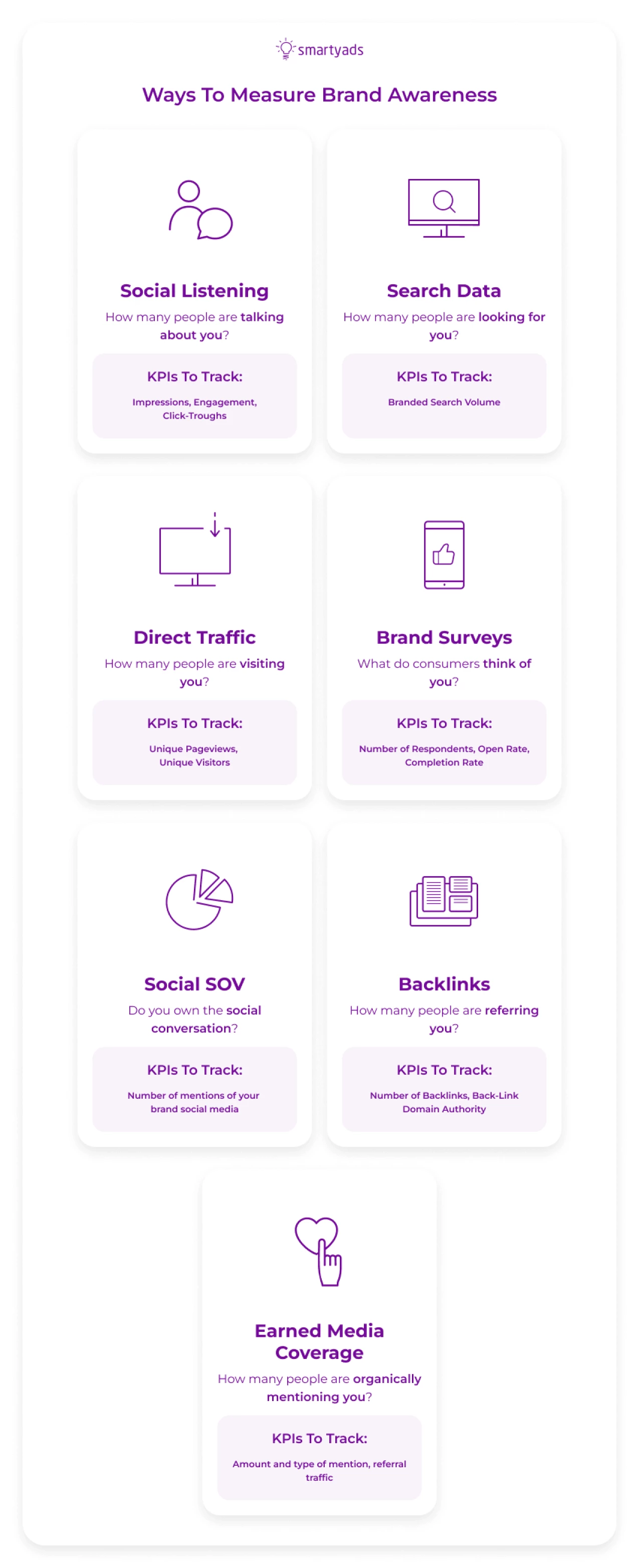
The multitude of metrics through which you can track awareness can make your head spin. Using different tools to measure brand awareness can be difficult, so you're probably wondering how to do it more easily and quickly.
The task, however, becomes easier when you need to measure KPIs for brand awareness of your advertising campaign on a demand-side platform. Marketers can track key metrics like impressions, reach, frequency, and engagement on such platforms easily as they not only run campaigns in real-time but also enable real-time analysis. Now, let’s find out how to measure it specifically on your advertising platform:
Impressions
Go to the "report" section and find out how your campaign is performing. Your perfect goal there is to serve the ads to as many targeted users as possible. Note that on DSP, impressions are targeted, which means they reach only those users whose cookie data corresponds to the targeting criteria you select (age, geo, language, etc.). It increases the likelihood of conversion and prevents serving ads to people outside the brand's targeted audience.
Click-through rate (CTR)
CTR shows the impressions-to-clicks ratio. It can be calculated according to the following formula: clicks/impressions. On programmatic ad platforms like SmartyAds, you can automatically obtain the CTR rate in the analytics. High CTR will mean that users actively engage with your campaigns and find them relevant.
Pro tip: The more impressions your campaign will generate, the more unique visitors you will receive on your website, so the better your metrics will be. At the brand awareness stage, we recommend using awareness-focused advertising formats like display ads, in-stream videos, and Connected TV.
Viewability Rate
The percentage of your ad impressions that are actually viewable by users (e.g., at least 50% of the ad's pixels are in view for a minimum of one second for display ads or two seconds for video ads). So, how to measure brand awareness in terms of VCR? When it comes to the completion rate for the videos, VCR is used to measure the percentage of users who watch your video ad to the end. A higher VCR indicates that your audience is engaged with your video content.
Video Completion Rate (VCR)
Video completion is used for videos and helps advertisers determine whether customers are really interested in the product or service. As the name suggests, this metric measures whether potential customers watch the promo video to the end or skip it altogether. For example, you run a 15-second commercial video, and some users may skip it, but those who watch it till the end reach 100% VCR, which is a perfect rate.
Reach & Frequency
Imagine you are hosting a big party and sending out invitations. The biggest questions you face are “how many people actually received my invite” and “how often they glanced at my digital invitation.” All those questions are about reach and frequency. Same with ad campaigns. If your campaign reaches 100,000 people, that’s 100,000 unique users who saw it at least once. Then, in case you served 500,000 impressions and reached 100,000 people, the frequency you achieved is 5, because each person saw it around 5 times.
Key brand awareness KPIs for greater impact
Choosing the right brand awareness metrics is crucial as they enable measurement, evaluation, goal setting, and strategy alignment. These metrics help assess how well your brand is breaking through the noise — tracking awareness levels, calculating the ROI of upper-funnel campaigns, benchmarking against competitors, and providing much-needed accountability.
But traditional KPIs alone won’t cut it anymore. By incorporating attention metrics in advertising — such as dwell time, gaze duration, and interaction depth — you get a clearer picture of not just if your brand is being seen, but how meaningfully it’s being noticed.
Measuring these alongside standard KPIs allows businesses to track real progress, optimize strategies with more nuance, allocate resources more effectively, and ultimately prove the real-world impact of their brand awareness initiatives. Because let’s face it — awareness without attention is just background noise.
What metrics can your ad platform measure?
The typical DSP advertising platform has in-built analytics that generates reports across numerous real-time metrics. These include but are not limited to Impressions, Clicks, and CTR. However, the key indicator is the number of impressions.
Hitting additional goals
You might want to hit additional goals like achieving higher conversions and sales. Thus, before starting an ad campaign on DSP, we recommend studying your targeted audience in order to work better with your objectives. As soon as you discover who your audience is, it's time to decide how they should interact with your brand.
Example. You are a startup or a new company that is launching a product or service for the first time. You need recognition and awareness. Still, you will be interacting with people for the first time. To address new users, you need to measure KPI advertising metrics that belong to the top of the conversion funnel.
If your primary goal is affinity, you might also focus on interaction with creatives, such as measuring video completion (if you apply video ad formats). After this, you can measure secondary KPI for an advertising campaign, e.g., time spent on the website. You can also define the audience segments that actually complete the video to remind them about your product or service in a retargeting campaign, and so on.
Interaction with creatives
It is also very important to track how users interact with your creatives. For this, advertisers can apply third-party tracking pixels on DSP platforms like SmartyAds and then track how users interact with ads, whether they click on them or not.
Pro tip: Use high KPI display ads, native ad formats, and engaging interactive videos like rewarded and playable in-game formats. They will help you capture the users' attention at the consideration stage. Interactive formats like these provide the greatest options in terms of behavioral tracking mechanisms.
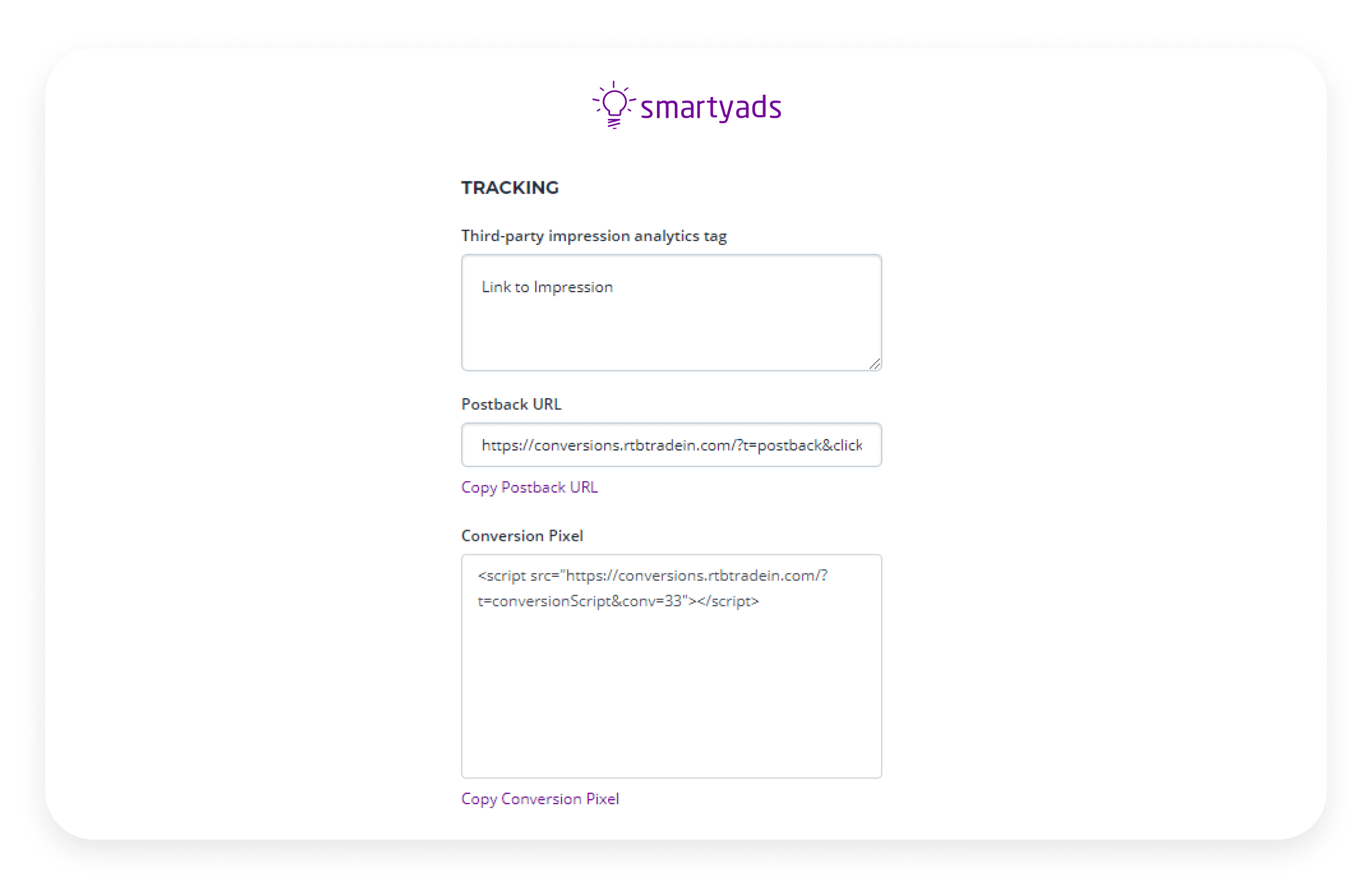
Programmatic advertising KPIs for conversion
Brand consideration metrics are no less important than key performance indicators for brand awareness, as they measure to what extent your audience is ready to buy the offered product or service. The most important of those are:
Clicks
The DSP brand awareness campaign can also be measured in the total number of clicks. Such brand awareness KPIs like the number of clicks let you see how many clicks were generated out of the total number of served impressions during the period. For CPM advertising campaigns, this metric shows how many clicks an advertiser managed to generate out of 1000 served impressions. Same way as CTR, it is automatically calculated on a programmatic DSP.
Sales
It is an easy-to-use KPI to measure brand awareness on programmatic platforms. If you need to measure such key performance indicators as the number of sales, go to Google Analytics. For this, you can configure a sales performance report. After this, you will be able to see the total generated revenue, changes in conversion rate, and average order value during the period.
Branded search volume
Branded search volume refers to the number of searches conducted by users, specifically using a brand's name or variations of it as the search query. It represents users' level of interest and intent to find information, products, or services related to a particular brand.
Branded search volume is a metric that helps measure a brand's popularity, recognition, and relevance in the online space. Higher volume indicates a strong brand presence and customer loyalty, as users actively seek out information or engage with the brand directly.
Pro tip: If your previous efforts to raise brand awareness and engagement didn't go in vain, your target audience would most likely complete the purchase. At this stage, your campaign optimization should encourage this final action; we highly recommend applying native creatives and launching retargeting campaigns across different mediums.
So, if you are still wondering how to measure brand awareness KPI, use the table below.
Key brand awareness KPI advertising metrics and tactics
| Goal | Key performance indicator (KPI) | Tactics |
Awareness/Site traffic
Getting better recall and recognition, finding new users |
CTR (↑) Impressions (↑) Unique users (↑) | Display ads In-stream videos Connected TV |
Consideration
Positioning the brand as a thought leader and expert | Video watching and completion (↑) Time on site (↑) |
Display ads Native ads Rewarded video Playable ads |
Conversion Elevating sales and conversions | Clicks(↑) Sales(↑) | Native ads Retargeting |
Enabling competitive analysis
Comparative surveys can offer insights into how a brand fares against its competitors in terms of awareness levels. This information helps businesses understand the competitive landscape and adjust their strategies accordingly. Compare brand awareness metrics before and after running your campaign to assess the uplift and effectiveness of your DSP advertising efforts.
Successful brand awareness campaigns
Below, you will see how successful brands normally develop strong strategies for building really impactful advertising campaigns.
Campaign: Coca-Cola's "Share a Coke" -- core appeal is personalization
Strategy: Coca-Cola replaced its iconic logo on bottles with 250 of the most common names in each market.
Description: This personalization made the campaign highly engaging, encouraging consumers to find and share bottles with their names or the names of friends and family. It created a personal connection between the consumer and the product, driving both awareness and sales.
Campaign: Always' "#LikeAGirl" -- the core appeal is emotional impact
Strategy: The campaign aimed to redefine the phrase "like a girl" to boost girls' self-confidence.
Description: By addressing a social issue and focusing on empowerment, the company created a powerful emotional connection with its audience. The campaign's viral video challenged stereotypes and encouraged people to share and discuss the message, increasing brand awareness through emotional resonance.
Campaign: Dove's "Real Beauty Sketches" -- the core appeal is engagement
Strategy: Dove used a forensic artist to draw women as they described themselves and then as others described them.
Description: The campaign highlighted the gap between self-perception and how others see us, promoting a message of self-esteem and real beauty. By involving real women and creating a compelling narrative, Dove engaged its audience on a deep, personal level, driving high levels of sharing and discussion.
Campaign: Oreo's "Daily Twist" -- the core appeal is achieved via social media integration
Strategy: Oreo created a new, timely image every day for 100 days, integrating social media trends and current events.
Description: By leveraging current events and social media trends, Oreo kept its content fresh and relevant. This approach encouraged frequent sharing and kept the brand top-of-mind for consumers, boosting brand visibility and brand KPIs on social media platforms.
Campaign: Starbucks' "White Cup Contest" -- the core appeal is achieved thanks to the user-generated content
Strategy: Starbucks invited customers to decorate their white Starbucks cups and submit photos of their designs.
Description: This campaign leveraged the creativity of its customers, turning them into brand advocates. Their brand awareness measurement showed that user-generated content not only increased engagement but also provided authentic and diverse representations of the brand, enhancing its appeal and reach.
Campaign: TOMS' "One for One" -- the core appeal is achieved thanks to the application of cause marketing
Strategy: For every pair of shoes sold, TOMS donated a pair to a child in need.
Description: By aligning the brand with a social cause, TOMS built a strong emotional connection with consumers who wanted to make a positive impact. This strategy helped differentiate TOMS in a crowded market and fostered a loyal customer base, while significantly increasing brand awareness.
Campaign: Red Bull's "Stratos" -- experiential marketing is a core of their appeal
Strategy: Red Bull sponsored Felix Baumgartner’s free fall from the stratosphere.
Description: This high-risk, high-reward event captured global attention and was broadcast live across multiple platforms. The extreme nature of the stunt perfectly aligned with Red Bull’s brand image of pushing limits, creating massive media coverage, and consumer engagement.
Campaign: Nike's "Find Your Greatness" -- aptly uses storytelling to achieve the core goal
Strategy: Nike featured everyday athletes from around the world, showcasing their personal achievements and struggles.
Description: By focusing on relatable, personal stories, Nike inspired and resonated with a broad audience. The campaign reinforced Nike's brand message of empowerment and perseverance, driving both emotional connection and widespread sharing.
Campaign: Starbucks' "Red Cups" -- advertisers that know how to use seasonal themes
Strategy: Every holiday season, Starbucks releases special red cups.
Description: This annual campaign creates anticipation and excitement among consumers, making the red cups synonymous with the holiday season. The limited-time nature of the cups and the associated festive marketing drive both brand awareness and seasonal sales.
By evaluating the level of recognition and familiarity your target audience has with your brand, you gain valuable insights for strategic decision-making. Understanding how effectively your marketing efforts generate brand visibility helps you gauge your brand's position in the market and identify areas for improvement or differentiation compared to your competitors.
Moreover, measuring brand awareness allows you to assess the effectiveness of your marketing campaigns and channels, enabling you to optimize your strategies and allocate resources more efficiently.
How SmartyAds helps you track brand awareness KPIs
The great news is that SmartyAds DSP makes it easy for advertisers to measure the impact of their advertising endeavors thanks to easily adjusted KPI campaign metrics and other important elements and features of our platform. See what programmatic advertising KPIs our platform can offer:
| KPI | How SmartyAds DSP Helps You Use It |
Bids (Number of bid requests your campaign sends to participate in ad auctions) | SmartyAds tracks bids in real time to show how well your campaign is competing for impressions. |
Wins (Number of auctions your campaign successfully wins) | Win data reveals how competitive your bid strategy is and helps optimize bidding to reach more users. |
| Impressions (Number of times your ad is shown) | Real-time impression tracking shows how widely your campaign is reaching your target audience. |
Clicks (Number of times users click on your ad) | Helps assess initial engagement and interest — especially useful in evaluating awareness-driven creatives. |
Spend (Total money spent on the campaign) | Transparent, real-time spend tracking helps you control budget pacing and measure cost-efficiency of brand reach. |
| eCPM (Effective cost per 1,000 impressions) | Calculated automatically by DSP; used to monitor how much it costs to gain brand exposure at scale. |
| CTR (Click-through rate = clicks ÷ impressions) | A key sign of message resonance — SmartyAds automatically displays CTR for every campaign and allows optimization. |
| Win Rate (Wins ÷ Bids — percentage of auctions you win) | Indicates bid competitiveness and helps adjust strategy to increase reach in crowded or costly inventory. |
These metrics are easily adjustable in your programmatic DSP reports (in your dashboard) so you know how to measure brand awareness easily.
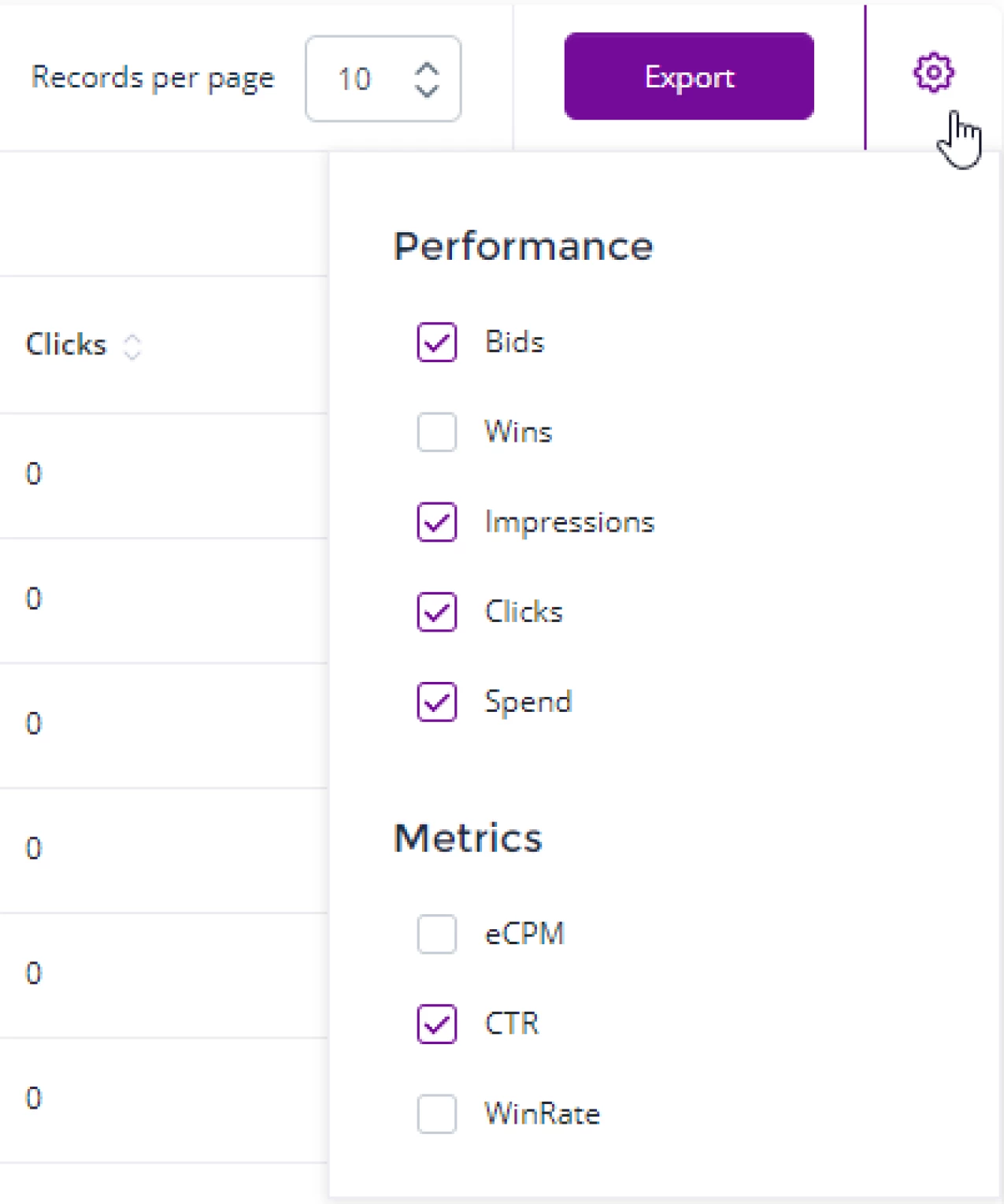
Bonus DSP features for awareness:
- Real-time dashboard: Visualize all the above KPIs per campaign.
- Custom optimization rules: Set conditions to boost impressions, block low-performance sources, or increase CTR automatically.
- Omnichannel support: Track and compare KPIs across CTV, mobile, desktop, DOOH, and more — all from one place.
The last word
When your product or service gains recognition, it is important to track how the overall campaign is performing, how exactly users react to ads, and how many clicks and sales it generates in order to compile a better kpis brand awareness strategy in the future.
With programmatic platforms like SmartyAds DSP, you can select the right KPI for advertising campaigns and apply strategic optimizations to ensure they always reach their full potential.
Reach and measure your key performance advertising KPI on SmartyAds DSP!
FAQ
Measuring brand awareness KPIs shows whether potential customers recognize your brand. Consistently strong KPIs indicate effective marketing and advertising—critical for building customer trust.
Programmatic is a primary tool designed for effective branding campaigns. It is largely built upon the CPM payment model, which ensures the most expansive reach: You pay per 1000 impressions. Aside from measuring brand kpis in real-time, you can use precise targeting, real-time optimization, and reporting.
While traditional KPIs are based on quantity – counting impressions or number of clicks, attention metrics are wrapped around measuring the quality of engagement. These can include time of watching or user interaction.

